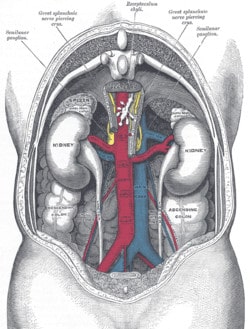A commonly used stenting procedure to treat plaque build-up in the renal artery appears to offer no significant improvement when added to medication-based therapy, according to results from a National Institutes of Health-funded study. The narrowing and hardening of one or both renal arteries, known as renal artery stenosis, occurs in 1 to 5 percent of people who have high blood pressure, or hypertension.
The findings were presented at the American Heart Association (AHA) 2013 Scientific Sessions in Dallas today and appeared concurrently in the New England Journal of Medicine.
Renal artery stenosis can lead to conditions such as chronic kidney disease and can appear alongside conditions including coronary artery disease. Effective treatment of renal artery stenosis can improve blood pressure control, stabilize kidney function, and reduce incidence of serious cardiovascular events.
“Demonstrating the ineffectiveness of certain medical procedures can be as valuable as proving the effectiveness of treatment techniques,” said Dr. Michael Lauer, director of the Division of Cardiovascular Sciences in the National Heart, Lung, and Blood Institute, which supported the study. “The findings from this study could help change clinical practice by encouraging health care providers to avoid unnecessary stenting procedures when treating renal artery stenosis.”
According to the study’s researchers, between 1996 and 2000, there was a 364 percent jump in renal artery stenting procedures for Medicare beneficiaries. The procedure involves inserting a metal mesh tube into an artery to open the clogged passageway. An estimated 78 million Americans have hypertension, according to the AHA, and as many as 3.9 million people in the United States may have renal artery stenosis.
“Renal artery stenting for this condition remains a common practice because while several, smaller studies showed negative results, other research has suggested the procedure may help lower blood pressure and stabilize kidney function,” said Dr. Christopher Cooper, lead author of the study and chairman of the Department of Medicine at the University of Toledo, Ohio. “Our larger study demonstrates that this procedure offers no incremental benefit when added to treatment with medication.”
The Cardiovascular Outcomes in Renal Atherosclerotic Lesions study, known as CORAL, studied 947 patients whose plaque build-up in the renal artery narrowed the blood vessel by 60 percent or more. Participants, whose average age was 69 years, had renal artery stenosis and either systolic blood pressure of 150 mmHg or higher while taking two or more drugs or Stage 3 (moderate) chronic kidney disease. Researchers from more than 100 institutions randomly assigned participants to receive medical therapy only or medical therapy plus a stent. The research team examined the effect of the two treatment options on a combination of cardiovascular and renal outcomes that included death from renal or cardiovascular causes; heart attack; hospitalization for congestive heart failure; progressive renal insufficiency; or renal replacement therapy, which includes the need for dialysis or renal transplantation.
During an average follow-up period of 43 months, researchers found that 35.1 percent of patients who received medical therapy and stents experienced one of the negative endpoints versus 35.8 percent of patients who received medication alone.


